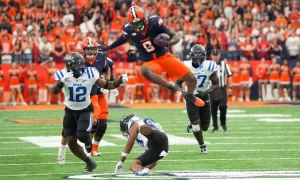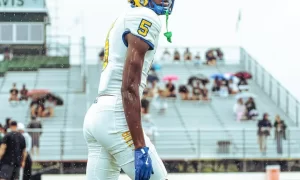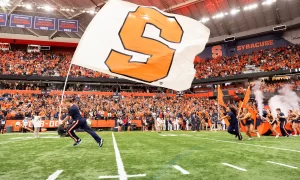 The college football landscape grunted, belched and seemed to move under our feet over the weekend, conference expansion and realignment rumors swirling everywhere. While Texas A&M’s much-discussed move to the SEC seems dormant for now, any potential movement within the BCS forces Syracuse fans to jump, like touching a door knob with static electricity.
The college football landscape grunted, belched and seemed to move under our feet over the weekend, conference expansion and realignment rumors swirling everywhere. While Texas A&M’s much-discussed move to the SEC seems dormant for now, any potential movement within the BCS forces Syracuse fans to jump, like touching a door knob with static electricity.
It’s a sensitive subject for all of us in the Big East, the life raft that was left for dead in 2004 when Miami, Virginia Tech and Boston College’s departures were supposed to render the conference obsolete – pillaged and gasping for air.
Eight years later, the Big East’s basketball strength is unquestioned and the Supermarket Sweep decision by the ACC to grab all those high-priced football program salamis out of the cooler is not quite a slam dunk. The ACC’s basketball got watered down and its supposed superior gridiron product? Eh.
- Follow The Fizz on Twitter for live Syracuse football updates
But no one can escape the Big East’s tenuous national hold in football, and as we all know that’s what drives the bus. While the conference has a healthy payday from ESPN for the Big Monday package and the Big East tournament, all that huge TV money that gets thrown around for football and bowl tie-ins sounds pretty good.
The good news? Syracuse is in line to land on its feet if (when) conference realignment happens either to four 16-team super leagues or some precursor of that. Speaking with multiple sources with knowledge of the ongoing expansion talks, SU provides a solid enough brand, market share and academic reputation to survive college football armageddon.
Hypothetically, should the dominoes begin to fall and the ACC or the Big 10 begin grabbing new pieces, Syracuse would be in line to nab one of those slots. Here’s why:
- Geography
In the northeast, which provides major television eyeballs, Syracuse is a commodity. Darryl Gross has attempted to market his program as “New York’s College Team” for exactly this reason. There are plenty of alumni that comprise a fan base in the Big Apple and Long Island, plus you own the Buffalo market. In this regard, Rutgers and UConn are also safe. RU delivers the densely-populated state of New Jersey, while Connecticut gives you the Hartford market. SU is also not fighting in-state rivals that would rather keep the footprint to themselves (i.e. Clemson vs. South Carolina, FSU vs. Florida). In this way, Pitt may forever be held out of the Big 10 by Penn State, Cincinnati by Ohio State, Louisville could be blocked by Kentucky and USF by any of the Big 3 Florida schools. Other losers: West Virginia.
- Brand
While Orange Nation may lament the aging sterility of the Carrier Dome and debate whether Jim Boeheim can ever win another title, SU has built a strong brand within college sports. The Dome is iconic, The Per’fesser is a Hall of Famer, the basketball program is a perennial contender and football has produced recognized names in Jim Brown, Ernie Davis, and Donovan McNabb. Other winners: Pitt, UConn (hoops), Louisville (hoops). Losers: USF, Cincinnati.
- Academics
While it might be drenched in insincerity, the academic reputation of a school is a constant topic of discussion for conference commissioners. Ultimately, Jim Delaney doesn’t care if Johnny Huskerseed graduates from Nebraska with a 4.0 or a 1.2 GPA. But the great charade in college athletics is the “student-athlete” and importance of “academic profile.” The Huskers were invited to the Big 10 because of football dominance and a national pigskin brand, but they also had to fit into the politics. The U.S. News & World Report ranks Nebraska lower than all 12 Big Ten schools, but its membership in the Association of American Universities, or¬†AAU, gave it enough academic juice to make the jump.
Syracuse’s academic reputation is extremely strong, alongside Boston College as two of the highest-ranking BCS schools in the Northeast. Private schools like SU suffer when it comes to money for facilities (the lack of state-funding), but find strength in academics because its classroom standards are much higher than public institutions. Also, if APR numbers begin deciding what schools are eligible for the postseason (as last week’s NCAA discussions suggested), academic numbers become vital to conferences. Other winners: Pitt, Rutgers. Losers: Louisville, USF, WVU.
- Numbers
Syracuse is specifically safe if the suggested “superconference theory” becomes reality.The ACC and Big 10 both need four more schools to make that happen, meaning a total of eight additional programs between the two conferences. That number could jump to 10 new schools if the ACC loses Florida State and Clemson to the SEC. Syracuse is solidly in that group because of the aforementioned qualities. Other programs guaranteed to be added to a superconference: Pitt, UConn, Rutgers.
SU would help itself by turning around the football program even more dramatically. While Doug Marrone has clearly put the Orange moving in the right direction, the glow of SU football from the ’80s and ’90s has worn off. Becoming one of the powers of the Big East would help tremendously and major upgrades on the facilities (like the Melo Center for hoops) can make the Orange stand out even more.
It may still be years away, but the constant shuffling and reshuffling of the BCS will always leave SU fans weary. If the superconference theory comes to fruition, those 64 schools would have the opportunity to break out from under the NCAA umbrella and create their own basketball tournament and college football playoff, while playing by their own rules and keeping all the cash. But fear not, Syracuse is set to be one of the schools in the getaway car. Let’s just hope we all don’t crash once we get there.
Posted: D.A.





















